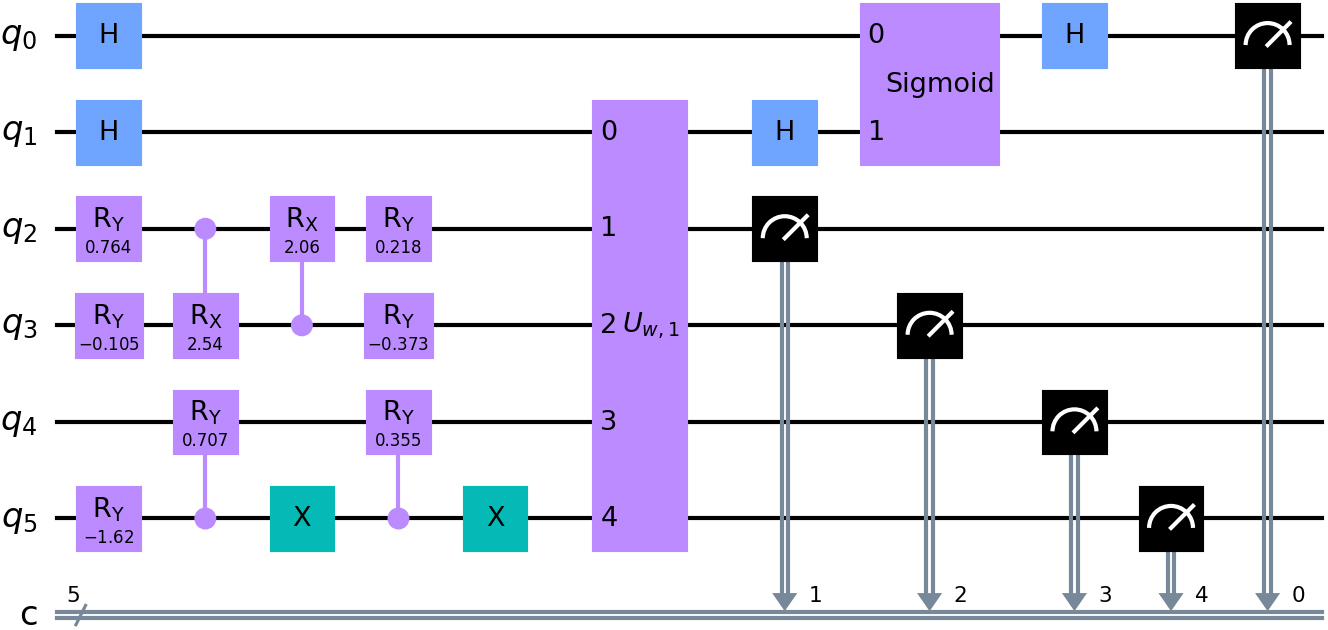Quantum Computing for Financial Mathematics
The discipline of financial mathematics has experienced many periods of rapid development that are often followed by relative calm. As a synthetic discipline at the cross section of applied mathematics, financial theory, computer science, prudential regulation, and other fields, financial mathematics benefits from discoveries and breakthroughs in all of these areas. The birth of financial mathematics is often attributed to Louis Bachelier’s doctoral thesis, “The Theory of Speculation,” which he defended in 1900 under the supervision of Henri Poincaré. Bachelier was the first person to utilize a stochastic process (later called Brownian motion) to model financial assets. Since then, financial mathematics has felt the influence of stochastic calculus (e.g., Itô’s lemma and the Girsanov theorem), control theory (e.g., the Kalman filter), and statistics (e.g., the Kolmogorov-Smirnov test) while also benefitting from progress in microprocessors, financial deregulation, ultrafast communication, and object-oriented programming.
Quantum computing, which promises enormous computing power at a very low cost, marks the start of a new chapter for financial mathematics. All financial problems—pricing, risk management, credit scoring, discovery of trading signals, data encryption, portfolio optimization, and so forth—are computational in nature, and financial mathematics seeks to provide the most efficient and convenient tools for these types of computations.

A computation is a function that transforms information, or the transformation of one memory state into another. In classical digital computing, the fundamental memory unit is a binary digit (bit) of information. Logic gates are functions that operate on bits of information — namely Boolean functions, which can be combined into circuits that perform additions, multiplications, and more complex operations. But is Boolean logic the sole or most general way to realize digital computation? The answer is clearly “no.” Classical computing is just a special case of a more general computational framework that we now call quantum computing. A classical bit is a two-state system that can exist in one of two discrete deterministic states, traditionally denoted as \(0\) and \(1\). All classical bits are independent, in that flipping the state of a given bit does not affect the states of other bits. To generalize these two features of classical computing, we can permit the bit to exist in a superposition of the two states and allow the states of different bits to entangle (a certain form of correlation). It is therefore clear how quantum computing got its name; superposition and entanglement are the key characteristics of quantum system states, and it is tempting to perform these computations with the controlled evolution of a quantum system, i.e., by running a quantum computer.
Superposition and entanglement are also responsible for the extraordinary power of quantum computing. They allow for more general computation, a broader definition of the memory state as compared to classical digital computing, and a wider range of possible transformations of such memory states. The fundamental memory unit in quantum computing is the quantum bit (qubit). Mathematically, a qubit’s state is a unit vector in the two-dimensional complex vector space. Norm-preserving unitary operators (unitary matrices) that act on qubit states serve as quantum logic gates. Once a computation is complete and the quantum circuit (a sequence of quantum logic gates) has transformed the initial system state, we can measure the qubit states by projecting them onto the basis states (see Figure 1). Qubits in their basis states correspond to classical bits, as all superpositions have collapsed. The remainder of the computational protocol can occur classically after the readout of the bitstring from a quantum computer.

Why have researchers not utilized this superior mode of computation until very recently? Although quantum mechanics was formulated nearly a century ago, the realization of quantum mechanical rules in the computational protocol of classical digital computers requires an enormous amount of memory. Exponential gains in computing power are offset by exponential memory requirements.
In order to efficiently perform quantum computations, we must use the ability of actual quantum mechanical systems to encode information in their states. For instance, we can describe the state of a quantum system that consists of \(n\) entangled qubits by specifying \(2^n\) probability amplitudes: a massive amount of information that would be impossible to store in classical memory. Decades passed before quantum processing units (QPUs)—devices that control quantum mechanical systems as they perform computations—became technologically feasible.
Current state-of-the-art QPUs contain several hundred qubits, and the qubit fidelity is still insufficient for fault-tolerant computation. However, the size and qubit fidelity of these systems are already sufficient enough to be useful. Two qubit types in particular stand out as the most developed and most promising: qubits made of superconducting circuits with a coherence time of \(\sim 10^{3} \mathrm{\mu s}\) [10] (see Figure 2), and qubits made of trapped ions with a coherence time of \(>10^{8} \mu \mathrm{s}\) [2] (see Figure 3). These qubit characteristics indicate that we are approaching the threshold beyond which various error correction algorithms become feasible, meaning that we may finally enter the era of fault-tolerant quantum computing.

While Google demonstrated so-called quantum supremacy on a specially designed problem in 2019, recent work has exhibited clear signs of quantum advantage: productive applications of quantum computers to real-world problems that classical computers have trouble handling. That being said, emulators play a pivotal role in the current quantum ecosystem due to the scarcity and cost of full-fledged quantum computers. These emulators simulate quantum operations on classical hardware and enable researchers and developers to design, test, and refine quantum algorithms without direct access to a quantum machine, thus propelling state-of-the-art research and bypassing current limited availability. Given their parallel processing capabilities, graphics processing units have emerged as the go-to hardware for the emulation of quantum systems. Their architecture is well suited to handle the matrix operations that are fundamental to quantum mechanics. In recent years, large technology companies have begun to create public frameworks for quantum computing. For example, IBM’s Qiskit allows any Python user to implement and test quantum algorithms; Google Quantum AI provides the Cirq framework that lets developers create, edit, and invoke quantum circuits on real and simulated quantum devices; the Microsoft Azure Quantum Development Kit includes the Q# language, which developers can use to write quantum algorithms that run on classical simulators; and Xanadu’s PennyLane is specifically designed to implement quantum machine learning (QML) tools.
Several aspects of quantum computing are especially relevant to financial mathematics problems.
Optimization
Digital quantum computing allows practitioners to solve NP-hard combinatorial optimization problems with variational methods, such as the variational quantum eigensolver and the Quantum Approximate Optimization Algorithm [3]. Both algorithms can address a wide range of finance-related optimization problems [6]. Moreover, variational algorithms are noise resistant and therefore suitable for the current generation of noisy intermediate-scale quantum computers [9]. Classically hard optimization problems naturally lend themselves to implementation on analog quantum computers that realize the principles of adiabatic quantum computing. The flagship financial use case is discrete portfolio optimization, which demonstrates the first experimental evidence of a quantum speedup [11].
Quantum Machine Learning
The combination of quantum computing and artificial intelligence will likely generate some of the most exciting opportunities, including a wide range of possible applications in finance. We have already seen promising results with parameterized quantum circuits that were trained as either generative models (such as the quantum circuit Born machine [7]) or discriminative models (such as quantum neural networks). Possible use cases include market generators, data anonymizers, credit scoring, and the creation of trading signals. The quantum generative adversarial network (GAN) is another generative QML model with significant potential [1]. Much like classical GANs, quantum GANs comprise a generator and a discriminator with the ability to distinguish quantum states. Since each quantum state encodes a probability distribution, researchers can use the quantum GAN discriminator to verify whether the datasets in question came from the same probability distribution. This technique has direct applications to time series analysis, the detection of structural breaks, and alpha decay monitoring.
Partial Differential Equation Solvers
In 2009, Aram Harrow, Avinatan Hassidim, and Seth Lloyd devised a quantum algorithm that can surpass classical computation times when solving linear systems [5]. Linear systems are ubiquitous across applications, and many aspects of mathematical finance rely on the ability to solve these systems. The solution of partial differential equations (PDEs) is a particularly important application. In fact, a quantum algorithm for linear PDEs can efficiently price European and Asian options in the Black-Scholes framework [4].
Quantum Monte Carlo
Another quantum algorithm can accelerate Monte Carlo methods in a very general setting [8]. This algorithm estimates the expected output value of an arbitrary randomized or quantum subroutine with bounded variance, ultimately achieving a near-quadratic speedup over the best possible classical algorithm.
Quantum Semidefinite Programming
Quantum semidefinite programming (QSDP) is based on the observation that a normalized positive semidefinite matrix is naturally representable as a quantum state. On a quantum computer, operations on quantum states are sometimes computationally cheaper than classical matrix operations; this idea prompted the development of quantum algorithms for semidefinite programming. In finance, QSDP is potentially useful for maximum risk analysis and robust portfolio construction [6].
§
After decades of theoretical results, quantum computing is progressively becoming a reality. While full-scale quantum computers are not yet ready to replace their classical counterparts, they are nonetheless already useful in both speeding up specific procedures in classical algorithms (bringing forth the hybrid classical-quantum era) and providing new ways of thinking about old problems (so-called quantum-inspired algorithms). Rather than succumbing to quantum skepticism, we should instead embrace quantum computing as a valuable new tool that will help us more accurately address the numerous problems in quantitative finance.
The views and opinions expressed in this article are those of the authors and do not necessarily reflect the views and policies of their respective institutions.
Acknowledgments: Antoine Jacquier is supported by Engineering and Physical Sciences Research Council grants EP/W032643/1 and EP/T032146/1.
References
[1] Assouel, A., Jacquier, A., & Kondratyev, A. (2022). A quantum generative adversarial network for distributions. Quantum Mach. Intell., 4, 28.
[2] Bruzewicz, C.D., Chiaverini, J., McConnell, R., & Sage, J.M. (2019). Trapped-ion quantum computing: Progress and challenges. Appl. Phys. Rev., 6(2), 021314.
[3] Farhi, E., Goldstone, J., & Gutmann, S. (2014). A quantum approximate optimization algorithm. Preprint, arXiv:1411.4028.
[4] Fontanela, F., Jacquier, A., & Oumgari, M. (2021). A quantum algorithm for linear PDEs arising in finance. SIAM J. Financ. Math., 12(4), 98-114.
[5] Harrow, A.W., Hassidim, A., & Lloyd, S. (2009). Quantum algorithm for linear systems of equations. Phys. Rev. Lett., 103(15), 150502.
[6] Jacquier, A., & Kondratyev, O. (2022). Quantum machine learning and optimisation in finance: On the road to quantum advantage. Birmingham, UK: Packt Publishing.
[7] Kondratyev, A. (2021). Non-differentiable learning of quantum circuit Born machine with genetic algorithm. Wilmott, 2021(114), 50-61.
[8] Montanaro, A. (2015). Quantum speedup of Monte Carlo methods. Proc. R. Soc. A, 471(2181), 20150301.
[9] Preskill, J. (2018). Quantum computing in the NISQ era and beyond. Quantum, 2, 79.
[10] Somoroff, A., Ficheux, Q., Mencia, R.A., Xiong, H., Kuzmin, R., & Manucharyan, V.E. (2023). Millisecond coherence in a superconducting qubit. Phys. Rev. Lett., 130, 267001.
[11] Venturelli, D., & Kondratyev, A. (2019). Reverse quantum annealing approach to portfolio optimization problems. Quantum Mach. Intell., 1, 17-30.
About the Authors
Antoine Jacquier
Professor, Imperial College London
Antoine (Jack) Jacquier is a professor of mathematics at Imperial College London. His research focuses on quantum computing as well as stochastic analysis and volatility modeling in finance. Jacquier also serves as a scientific consultant and advisor for various finance and technology companies.

Oleksiy Kondratyev
Quantitative Research and Development Lead, Abu Dhabi Investment Authority
Oleksiy Kondratyev is the Quantitative Research and Development Lead at Abu Dhabi Investment Authority (ADIA). Prior to joining ADIA, he held quantitative research and data analytics positions at Standard Chartered, Barclays Capital, and Dresdner Bank. Kondratyev received the Risk Magazine Quant of the Year Award in 2019.

Gordon Lee
Head of Markets Quants, Bank of New York Mellon Corporation
Gordon Lee is head of the Markets Quants team at the Bank of New York Mellon Corporation.

Mugad Oumgari
Managing Director, Lloyds Banking Group
Mugad Oumgari is a managing director at Lloyds Banking Group. He received a postgraduate research degree in mathematics and a master’s degree in economics from the London School of Economics and Political Science.

Stay Up-to-Date with Email Alerts
Sign up for our monthly newsletter and emails about other topics of your choosing.



